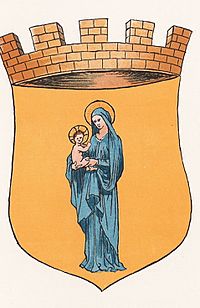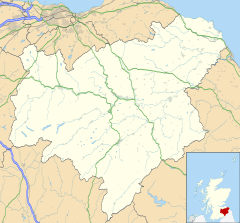Lauder facts for kids
Quick facts for kids Lauder
|
|
|---|---|
 Lauder Burgh Arms |
|
| Area | 0.63 km2 (0.24 sq mi) |
| Population | 1,850 (2020) |
| • Density | 2,937/km2 (7,610/sq mi) |
| OS grid reference | NT530475 |
| • Edinburgh | 23 mi (37 km) NW |
| Civil parish |
|
| Council area | |
| Lieutenancy area |
|
| Country | Scotland |
| Sovereign state | United Kingdom |
| Post town | LAUDER |
| Postcode district | TD2 |
| Dialling code | 01578 |
| Police | Lothian and Borders |
| Fire | Lothian and Borders |
| Ambulance | Scottish |
| EU Parliament | Scotland |
| UK Parliament |
|
| Scottish Parliament |
|
Lauder is a historic town in the Scottish Borders. It's known as a former Royal Burgh, which means it once had special rights granted by the King. You can find Lauder in the historic area of Berwickshire.
The town is located on the Southern Upland Way, a popular long-distance walking route. It sits about 27 miles (43 km) southeast of Edinburgh. Lauder is also on the western edge of the beautiful Lammermuir Hills.
Contents
What's in a Name? The Meaning of Lauder
The town of Lauder is in the valley of Leader Water. However, the names Lauder and Leader might not be connected. In old records, Lauder was called Lawedder and Loweder.
The name could come from an old British word, lǭwadr. This word means "washing or bathing place." Another idea is that Lauder's name is linked to a Middle Welsh word, llawedrawr, which means "a heap of ruins."
Lauder's Past: A Journey Through Time
Long ago, a Roman road called Dere Street passed through the Lauder area. Some historians think Malcolm III, a Scottish king, improved this road for his battles. It's one of the few old roads in Scotland named after a person.
The town of Lauder started as a "kirk-town" (a town with a church) around the 1100s. It was once surrounded by walls with gates called 'ports'. Two large mills, also from the 12th century, helped the town.
Feudal System and Early Families
When the feudal system came to Scotland, a powerful area called the Lordship of Regality of Lauderdale was created. This was for Hugh de Morville, a favorite of King David I. The de Morville family was very important in the area.
Records show that the de Morvilles owned part of Lauder. Another important family, the Lauders, also lived here even earlier. They owned the other part of the town's mill.
The Lauder Tower
The Lauder family built a strong stone building called a tower house. This tower was very important for the town's history. The town of Lauder grew up around it.
The tower was located near what is now the Easter Port. It stood until about 1700. Later, a church building was built on part of the old tower's site.
Lauder Town Hall
One of the notable old buildings in Lauder today is the former tolbooth, now known as Lauder Town Hall. It was built before 1598. Records show it was once burned down by rival families.
Thirlestane Castle: A Grand Home
Just outside Lauder, on Castle Hill, there was once a Crown Fort. This fort was the site of many battles. The English King Edward I built a new fort here. Later, Scottish kings James III and James IV used it too.
In 1548, the English took over the fort. After a short siege, they left in 1550. The Crown then gave the fort to the Lauder family.
Building a Palace
In 1587, John Maitland bought the land. Two years later, he started building the amazing Thirlestane Castle on the same spot. Parts of the old fort's walls were used in the new castle.
Later, in the 1670s, Sir William Bruce helped turn Thirlestane Castle into a grand palace. He redesigned it for the Duke of Lauderdale.
Lauder's Churches

Near the old Crown Fort was the ancient parish church of St. Mary. Many members of the old Lauder family were buried here. This included two bishops, William de Lawedre and Alexander Lauder.
In 1482, a sad event happened at this church. King James III's friends were taken from the church by angry nobles. They were then hanged from the old Lauder Bridge. Today, the sites of the old church and bridge are within the grounds of Thirlestane Castle.
The New Church
As Thirlestane Castle became grander, John Maitland, 1st Duke of Lauderdale decided to build a new church. Sir William Bruce designed this new kirk in 1673. It was built in the center of the Royal Burgh. Around it is a walled graveyard with a watchhouse. This watchhouse was built after a "bodysnatching" incident in 1830.
Lauder Today
In 2015, Lauder had about 1,803 people living there. Many people who live in Lauder now travel to Edinburgh for work. This is because Lauder is close enough to the capital city.
Recently, Lauder has seen some new developments. These include a new primary school and a new health center. The nearby Dun Law wind farm has also been expanded.
Famous People from Lauder
- Thomas Dickson (1822–1884), a successful businessman who founded The Dickson Manufacturing Company.
- Doddie Weir OBE, a famous rugby player.
More to Explore
- The Sir Walter Scott Way is a long-distance path that goes through Lauder.
- List of places in the Scottish Borders
- List of places in Scotland



